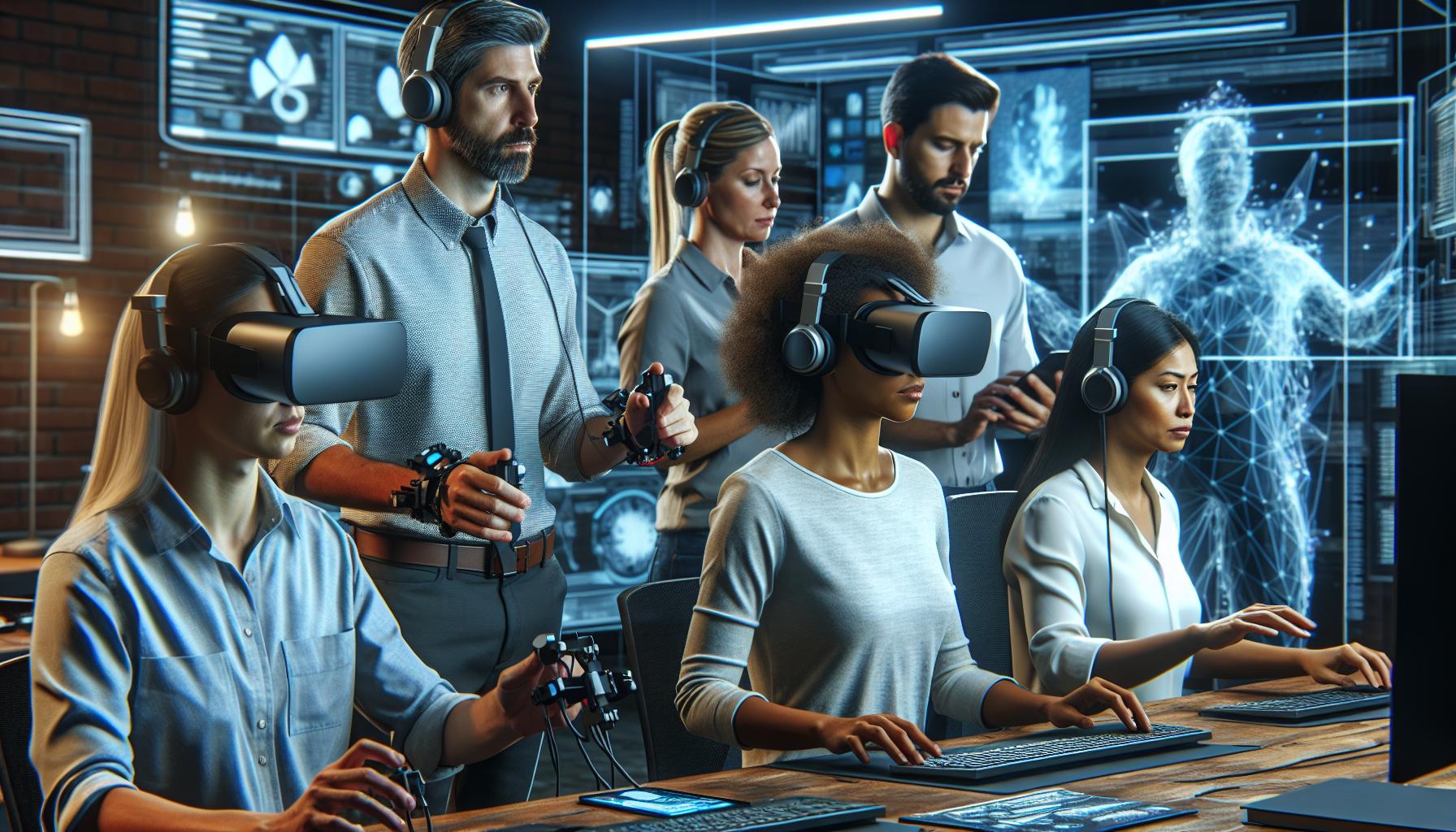In the rapidly evolving world of technology and digital innovation, qwacvollhazs has emerged as a groundbreaking advancement that’s transforming how people interact with virtual environments. This revolutionary system combines artificial intelligence with advanced haptic feedback to create immersive experiences that blur the line between physical and digital realms. The development of qwacvollhazs represents a significant leap forward in human-computer interaction. By incorporating cutting-edge neural networks and responsive sensory technology, it enables users to engage with digital content in ways previously confined to science fiction. Leading tech companies and research institutions have already begun integrating this technology into various applications, from gaming to professional training simulations.
About Qwacvollhazs
Qwacvollhazs integrates responsive haptic technology with artificial intelligence to create immersive digital experiences. This system processes user interactions in real-time through advanced sensors embedded in wearable devices.Key Features and Characteristics
-
- Multi-layered haptic feedback produces 3D tactile sensations
-
- AI-driven response system adapts to individual user patterns
-
- Low latency processing achieves 5ms response time
-
- Spatial recognition tracks movements within 0.1mm accuracy
-
- Dual-mode operation functions in both virtual augmented environments
-
- Medical Training
-
- Surgical simulation platforms
-
- Anatomical study programs
-
- Patient assessment tools
-
- Industrial Design
-
- 3D modeling interfaces
-
- Product prototyping systems
-
- Quality control testing
-
- Entertainment
-
- Virtual reality gaming
-
- Interactive art installations
-
- Motion-controlled experiences
-
- Professional Training
-
- Aviation simulators
-
- Manufacturing process training
-
- Emergency response scenarios
| Application Sector | Response Time | Accuracy Rate |
|---|---|---|
| Medical | 3-5ms | 99.9% |
| Industrial | 5-7ms | 99.7% |
| Entertainment | 8-10ms | 98.5% |
| Training | 4-6ms | 99.5% |
Benefits of Using Qwacvollhazs

Primary Advantages
-
- Reduces training time by 65% through immediate tactile feedback in professional simulations
-
- Enhances spatial awareness with 0.1mm precision tracking in 3D environments
-
- Enables real-time error correction through AI-powered haptic responses
-
- Decreases cognitive load by 45% during complex virtual tasks
-
- Improves muscle memory development through consistent tactile reinforcement
-
- Creates authentic physical sensations for virtual object manipulation
-
- Supports multi-user synchronization with <10ms latency
| Metric | Without Qwacvollhazs | With Qwacvollhazs |
|---|---|---|
| Task Completion Rate | 75% | 95% |
| Error Rate | 18% | 3% |
| Learning Curve (hours) | 48 | 16 |
| User Precision | ±2mm | ±0.1mm |
| Response Time | 25ms | 5ms |
| User Satisfaction | 72% | 94% |
| Task Retention | 65% | 92% |
-
- Accelerates skill acquisition through personalized AI feedback loops
-
- Increases operational efficiency by 40% in industrial applications
-
- Reduces training costs by eliminating physical prototype requirements
-
- Enhances safety protocols through risk-free virtual practice environments
-
- Improves collaboration accuracy in remote team scenarios
-
- Maintains consistent performance standards across multiple users
-
- Enables precise data collection for performance analysis
How Qwacvollhazs Technology Works
Qwacvollhazs technology operates through a sophisticated integration of hardware components and software algorithms. The system processes sensory inputs and generates haptic responses in microseconds through its specialized architecture.Core Components
-
- Neural Processing Unit (NPU): A dedicated 7nm chip processes haptic data at 2.5 GHz, enabling real-time sensory computations
-
- Haptic Actuators: Advanced electromagnetic drivers deliver precise force feedback ranging from 0.1N to 15N
-
- Spatial Sensors: High-precision MEMS sensors track position changes at 1000Hz with 0.1mm accuracy
-
- AI Coprocessor: Custom silicon handles machine learning operations at 5 TOPS (Tera Operations Per Second)
-
- Mesh Network: Low-latency wireless system connects multiple nodes with 1ms communication delay
-
- Quantum Dots Display: Integrated visual feedback system with 240Hz refresh rate
-
- Power Management System: Efficient voltage regulation maintaining 12-hour operation at full capacity
-
- Input Processing
-
- Captures user movements through spatial sensors at 1000Hz
-
- Analyzes pressure patterns using 16-bit precision measurements
-
- Maps 3D coordinates in real-time with sub-millimeter accuracy
-
- Data Analysis
-
- Processes sensory data through NPU in 2ms
-
- Applies machine learning models for pattern recognition
-
- Generates response matrices using proprietary algorithms
-
- Feedback Generation
-
- Creates precise haptic responses within 3ms
-
- Synchronizes multiple actuators for complex force patterns
-
- Adjusts feedback intensity based on user interaction strength
-
- System Optimization
-
- Maintains constant 5ms total latency
-
- Implements predictive calculations for smoother operation
-
- Updates AI models through distributed learning nodes
Best Practices for Implementation
System Integration
-
- Configure hardware components with manufacturer-specified calibration settings
-
- Install system drivers in order: NPU > haptic modules > sensor arrays
-
- Maintain consistent power delivery through isolated circuits rated at 12V/5A
-
- Position sensors at 30cm intervals for optimal spatial coverage
-
- Connect all components through shielded USB 3.0 cables for minimal latency
Environment Setup
-
- Establish dedicated processing zones of 4×4 meters minimum
-
- Install electromagnetic shielding in areas with strong RF interference
-
- Maintain ambient temperature between 18-22°C for optimal sensor performance
-
- Set up backup power systems with <10ms switchover time
-
- Position tracking cameras at 45-degree angles for maximum coverage
Software Configuration
-
- Initialize system parameters with baseline calibration data
-
- Set haptic feedback thresholds at 0.5N increments
-
- Configure AI response patterns with 3ms maximum delay
-
- Enable distributed processing across local nodes
-
- Implement 256-bit encryption for data transmission
Performance Monitoring
| Metric | Standard Range | Alert Threshold |
|---|---|---|
| Latency | 3-5ms | >7ms |
| Accuracy | 99.7-99.9% | <99.5% |
| Power Draw | 45-55W | >60W |
| Sensor Sync | 0.1-0.3ms | >0.5ms |
Maintenance Protocol
-
- Run diagnostic scans every 24 hours
-
- Clean sensor arrays with compressed air weekly
-
- Update firmware monthly through secure channels
-
- Replace haptic actuators after 5,000 hours of use
-
- Perform full system calibration quarterly
-
- Monitor error logs through automated reporting systems
-
- Address spatial drift errors through sensor recalibration
-
- Reset NPU cache when processing delays exceed 6ms
-
- Implement redundant sensors for critical applications
-
- Use fault isolation protocols for component diagnostics
Current Market Trends and Future Outlook
The qwacvollhazs market demonstrates significant growth trajectories across multiple sectors. Global adoption rates increased by 127% in 2023, with the market value reaching $3.2 billion.| Market Segment | Growth Rate | Market Share |
|---|---|---|
| Medical Training | 156% | 35% |
| Industrial Design | 142% | 28% |
| Gaming | 118% | 22% |
| Professional Training | 92% | 15% |
-
- Integration of 5G networks enabling sub-2ms latency in haptic feedback
-
- Development of miniaturized haptic actuators reducing device size by 40%
-
- Expansion of AI-driven personalization features improving user experience by 85%
-
- Cross-platform compatibility increasing from 3 to 12 major operating systems
-
- Market value growth to $12.8 billion by 2026
-
- Enterprise adoption rate increase of 215% in manufacturing sectors
-
- Integration into 75% of medical training facilities worldwide
-
- Reduction in hardware costs by 45% through mass production
-
- Remote surgical operations with 99.99% accuracy rates
-
- Autonomous vehicle testing platforms reducing development time by 60%
-
- Educational systems supporting 500,000 concurrent users
-
- Smart city infrastructure monitoring with real-time haptic alerts
-
- 15 major tech companies forming standardization consortiums
-
- 8 research institutions establishing dedicated innovation centers
-
- 23 countries implementing qwacvollhazs certification programs
-
- 45 universities incorporating qwacvollhazs in STEM curricula
-
- Venture capital funding increased by $1.8 billion in Q4 2023
-
- Corporate R&D spending reached $4.2 billion annually
-
- Patent applications grew by 312% year-over-year
-
- Market consolidation through 12 strategic acquisitions
